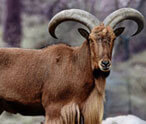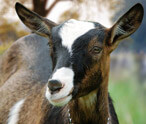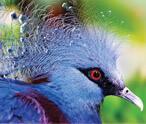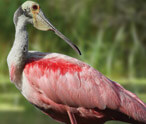Hippopotamus is a sub-aquatic animal and exists mostly in Africa’s sub-Saharan region. Its two species are known as H. amphibius and Choeropsis liberiensis according to scientific nomenclature. The bulky animal is next to elephants and rhinoceros in size and, therefore, earns the title of the world’s third largest ground mammal.
Hippos are as old as fifty-five million years when they first evolved. Scientists relate them to cetaceans, such as Whales and porpoises which are their evolutionary ancestors. The earliest fossil evidence of these large organisms is sixteen million years old. It belongs to Kenyapotamus genus.
On average, the formidable mammal measures around thirteen feet in length and five feet in height. It can be as heavy as three and a half ton. It is interesting how the animal’s enormous body is supported by its short and squat legs.
Another amazing quality of hippos is their surprisingly fast sprinting speed. Although they are bulky, they can easily overtake humans while running. Speed of thirty Km /hour has been recorded.
They seem to be calm creatures, lying peacefully in a water body. Beware: this is an extremely deceptive image of hippos. They are actually very aggressive and do not like intrusions. Therefore, do not fancy having a close look at them if you are out somewhere near their habitat.
Discover more hippopotamus facts and information through the following interesting discussion.
Hippopotamus Facts
- The animal has a plump body covered with thick, grey brown skin. The only hair bristles found on the body are near the mouth and at the tail's tip.
- Their feet have four toes each, which are webbed.
- Their tails are around 56 centimeter in length.
- There are no sweat glands on a hippo's skin. Instead, there are special glands which release a reddish fluid which is viscous in nature. It is mostly released during a state of excitement, but scientists believe that its function may be to keep the animal's body cool and prevent sunburn.
- The proof of its aggressiveness can be seen in the form of wounds and scars on its body which result from everyday scuffling.
- They like to stay in water all day in order to keep their bodies cool.
- Their eyes, nostrils and ears are found at the top of their heads. This adaptation enables them to stay under the surface of water. They can survive for six whole minutes when completely submerged in water.
- "Hippos" is a Greek word which means river horses. It is an appropriate name for these water loving organisms.
- Their ability to swim comes from their webbed feet which aid them in paddling through water.
- Although they can be a threat to other animals due to their aggressive nature, they do not hunt for meat. Instead, being herbivores, they eat plants.
- Their days are spent in resting, while nights are for feeding.
- The biggest threat to hippos is posed by human beings who kill them for their meat. Lions and crocodiles are also their predators.
- The species called H. amphibius is found in the southern part of Sahara in Eastern Africa. On the other hand, the habitat of Choeropsis liberiensis is in Western Africa.
- A baby hippo is born under water and is then aided by the mother to come to the surface, so that it can breathe.
- Maturity is attained at an age of seven years by males and nine years by females. Their total life span averages around fifty years.
Hippo Families
A hippo family consists of a group of around fifteen members with a large male being the dominating head. They stay in the same water body together. During times when scarcity of water occurs, other families may join them, making their water body crowded.
The male hippo has dominance over all female members of its family. Other intruding males are scared off by revealing the formidable canines. This warning sign may also be followed by actual fights.
The females are mostly involved in raising the young hippos. They spend eight months of gestation period. Birth usually takes place in the rain season. The mother teaches its calf to swim and protects it from predators, such as crocodiles and lions. Even adult hippos sometimes attack the babies.
Hippopotamus Pictures
Hippopotamus pictures can show you all the physical traits of this huge animal, yet interesting mammal. While looking at these photos, do observe the following features.
- Their deadly canine tusks are the most important weapon possessed by them for fights. These tusks can be as long as an entire foot.
- They have a hair-less skin.
- Their stubby legs which support the entire weight of the bulky body.
- The interesting position of their eyes, nose and ears on the head as they protrude out when the rest of the body is under water.
- There exist differences between males and female hippos.
- You can also find differences between their two species.
Of course, photos cannot reveal much about their behavior. Instead, you can look up for some videos related to hippos on the internet. Even better, you can observe them in a zoo where they are kept in large enclosures in a habitat which is close to their natural one.
Latest Mammals

Types Of Goats
Goat is a mammal that belongs... read more

Goat Facts
A domesticated form the wild goat of...read more

Giraffes Facts
Giraffes are creatures with extremely...read more
Latest Birds

Victoria Crowned Pigeon
With its name...read more

Information About Flamingos
Flamingos are...read more

Hoopoe Bird
Famous for its distinctive crown of...read more

Roseate Spoonbill
The beautiful Roseate Spoonbill...read more























Largest Birds of Prey in the World by Size and Weight
Also called raptors, the birds...
List of Birds That Fly in V Formation
Did you ever feast your eyes on the amazing phenomenon...
Birds of Prey List
A bird of prey is also known as a raptor or a hunter. It belongs to the group of...
Millipedes Vs Centipedes
Centipedes and millipedes are both arthropods from the group...
Difference Between Warm Blooded and Cold Blooded Animals
Every living organism...
Top 10 Extremely Dangerous Insects
The insects have been grouped in class 'insecta' of...
Sheep Vs Goat
The goat and the sheep are related to each other through the same family. They...
Animals with Blue-colored Blood
Humans and other vertebrates have red-colored blood running...
Birds, Mammals And Reptiles
Before coming to the question of common ancestry of birds...